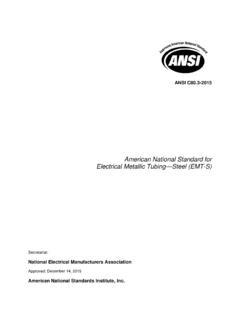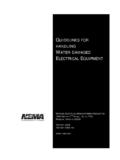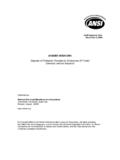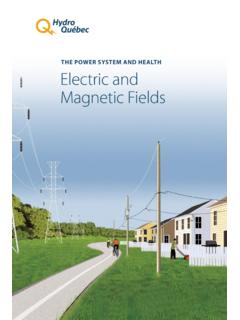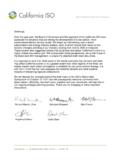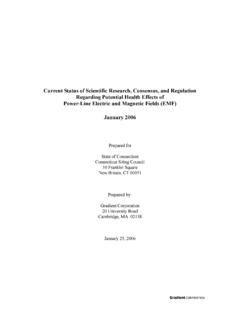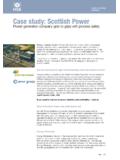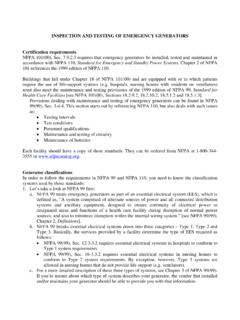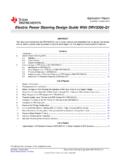Transcription of American National Standard For Electric Power …
1 ANSI Revision of ANSI American National Standard For Electric Power Systems and Equipment Voltage Ratings (60 Hertz) Secretariat: National Electrical Manufacturers Association Approved December 6, 2006 American National standards Institute, Inc. NOTICE AND DISCLAIMER The information in this publication was considered technically sound by the consensus of persons engaged in the development and approval of the document at the time it was developed. Consensus does not necessarily mean that there is unanimous agreement among every person participating in the development of this document. NEMA standards and guideline publications, of which the document contained herein is one, are developed through a voluntary consensus standards development process. This process brings together volunteers and/or seeks out the views of persons who have an interest in the topic covered by this publication.
2 While NEMA administers the process and establishes rules to promote fairness in the development of consensus, it does not write the document and it does not independently test, evaluate, or verify the accuracy or completeness of any information or the soundness of any judgments contained in its standards and guideline publications. NEMA disclaims liability for any personal injury, property, or other damages of any nature whatsoever, whether special, indirect, consequential, or compensatory, directly or indirectly resulting from the publication, use of, application, or reliance on this document. NEMA disclaims and makes no guaranty or warranty, express or implied, as to the accuracy or completeness of any information published herein, and disclaims and makes no warranty that the information in this document will fulfill any of your particular purposes or needs. NEMA does not undertake to guarantee the performance of any individual manufacturer or seller s products or services by virtue of this Standard or guide.
3 In publishing and making this document available, NEMA is not undertaking to render professional or other services for or on behalf of any person or entity, nor is NEMA undertaking to perform any duty owed by any person or entity to someone else. Anyone using this document should rely on his or her own independent judgment or, as appropriate, seek the advice of a competent professional in determining the exercise of reasonable care in any given circumstances. Information and other standards on the topic covered by this publication may be available from other sources, which the user may wish to consult for additional views or information not covered by this publication. NEMA has no Power , nor does it undertake to police or enforce compliance with the contents of this document. NEMA does not certify, test, or inspect products, designs, or installations for safety or health purposes.
4 Any certification or other statement of compliance with any health or safety related information in this document shall not be attributable to NEMA and is solely the responsibility of the certifier or maker of the statement. ANSI Copyright 2011 by National Electrical Manufacturers Association i American National Standard Approval of an American National Standard requires verification by ANSI that the requirements for due process, consensus, and other criteria for approval have been met by the standards developer. Consensus is established when, in the judgment of the ANSI Board of standards Review, substantial agreement has been reached by directly and materially affected interests. Substantial agreement means much more than a simple majority, but not necessarily unanimity. Consensus requires that all views and objections be considered, and that a concerted effort be made toward their resolution. The use of American National standards is completely voluntary; their existence does not in any respect preclude anyone, whether he has approved the standards or not, from manufacturing, marketing, purchasing, or using products, processes, or procedures not conforming to the standards .
5 The American National standards Institute does not develop standards and will in no circumstances give an interpretation of any American National Standard . Moreover, no person shall have the right or authority to issue an interpretation of an American National Standard in the name of the American National standards Institute. Requests for interpretations should be addressed to the secretariat or sponsor whose name appears on the title page of this Standard . Caution Notice: This American National Standard may be revised or withdrawn at any time. The procedures of the American National standards Institute require that action be taken periodically to reaffirm, revise, or withdraw this Standard . Purchasers of American National standards may receive current information on all standards by calling or writing the American National standards Institute. Published by National Electrical Manufacturers Association 1300 North 17th Street, Rosslyn, VA 22209 Copyright 2011 by National Electrical Manufacturers Association All rights reserved including translation into other languages, reserved under the Universal Copyright Convention, the Berne Convention for the Protection of Literary and Artistic Works, and the International and Pan American Copyright Conventions.
6 No part of this publication may be reproduced in any form, in an electronic retrieval system or otherwise, without the prior written permission of the publisher. Printed in the United States of America. ANSI ii Copyright 2011 by National Electrical Manufacturers Association This page intentionally left blank. ANSI Copyright 2011 by National Electrical Manufacturers Association iii Contents Page .. iv 1 Scope and purpose .. 1 Scope .. 1 Purpose .. 1 2 Definitions .. 1 3 System voltage classes .. 2 4 Selection of nominal system voltages .. 2 5 Explanation of voltage ranges .. 3 Application of voltage ranges .. 3 Range A service voltage .. 3 Range A utilization voltage .. 3 Range B service and utilization voltages .. 3 Outside Range B service and utilization voltages .. 3 6 Voltage ratings for 60-hertz Electric equipment.
7 4 General .. 4 Recommendation .. 4 Table 1 .. 5 Annex A Principal transformer connections to supply the system voltages of Table 1 .. 7 Annex B Illustration of voltage ranges of Table 1 .. 8 Annex C Polyphase voltage unbalance .. 9 Annex D Applicable standards .. 11 ANSI iv Copyright 2011 by National Electrical Manufacturers Association Foreword (This Foreword is not part of American National Standard ) This Standard supersedes American National Standard for Electric Power Systems and Equipment - Voltage Ratings (60 Hz), ANSI Standard nominal system voltages and voltage ranges shown in ANSI have been extended to include maximum system voltages of up to and including 1200 kV. In 1942, the Edison Electric Institute published the document Utilization Voltage Standardization Recommendations, EEI Pub. No. J-8. Based on that early document, a joint report was issued in 1949 by the Edison Electric Institute (EEI Pub.)
8 No. R6) and the National Electrical Manufacturers Association (NEMA Pub. No. 117). This 1949 publication was subsequently approved as American National Standard EEI-NEMA Preferred Voltage Ratings for AC Systems and Equipment, ANSI American National Standard was a pioneering effort in its field. It not only made carefully considered recommendations on voltage ratings for Electric systems and equipment, but also contained a considerable amount of much-needed educational material. After ANSI was prepared, the capacities of Power supply systems and customers' wiring systems increased and their unit voltage drops decreased. New utilization equipment was introduced and Power requirements of individual equipment were increased. These developments exerted an important influence both on Power systems and equipment design and on operating characteristics. In accordance with American National standards Institute policy requiring periodic review of its standards , American National standards Committee C84 was activated in 1962 to review and revise American National Standard , the Edison Electric Institute and National Electrical Manufacturers Association being named cosponsors for the project.
9 Membership on the C84 Committee represented a wide diversity of experience in the electrical industry. To this invaluable pool of experience were added the findings of the following surveys conducted by the committee: (1) A comprehensive questionnaire on Power system design and operating practices, including measurement of actual service voltages. (Approximately 65,000 readings were recorded, coming from all parts of the United States and from systems of all sizes, whether measured by number of customers or by extent of service areas.) (2) A sampling of single-phase distribution transformer production by kilovolt-amperes and primary voltage ratings to determine relative uses of medium voltages. (3) A survey of utilization voltages at motor terminals at approximately twenty industrial locations The worth of any Standard is measured by the degree of its acceptance and use. After careful consideration, and in view of the state of the art and the generally better understanding of the factors involved, the C84 Committee concluded that a successor Standard to ANSI should be developed and published in a much simplified form, thereby promoting ease of understanding and hence its acceptance and use.
10 This resulted in the approval and publication of American National Standard , followed by its supplement, ANSI , which provides voltage limits established for the 600-volt nominal system voltage. The 1977 revision of the Standard incorporated an expanded Foreword that provided a more complete history of this Standard s development. The 1970 revision included a significantly more useful Table 1 (by designating preferred system voltages), the 1977 revision provided further clarity, and the 1982 revision segmented the system voltages into the various voltage classes. ANSI Copyright 2011 by National Electrical Manufacturers Association v With the 2006 revision, the scope expanded to include voltages above 230 kV. This increased voltage range was previously covered by IEEE Std 1312-1993 (R2004), IEEE Standard Preferred Voltage Ratings for Alternating-Current Electrical Systems and Equipment Operating at Voltages Above 230 kV Nominal, and its predecessor, ANSI With the 2011 revision, Table 1 was modified to reflect changes in lighting characteristics.
